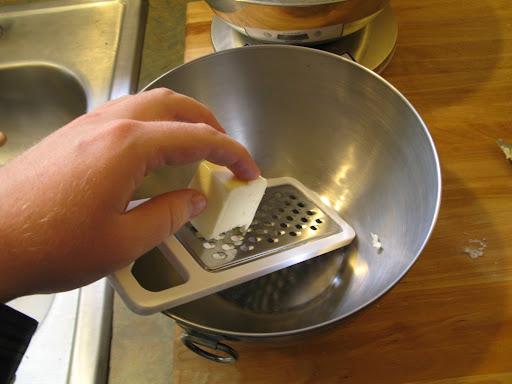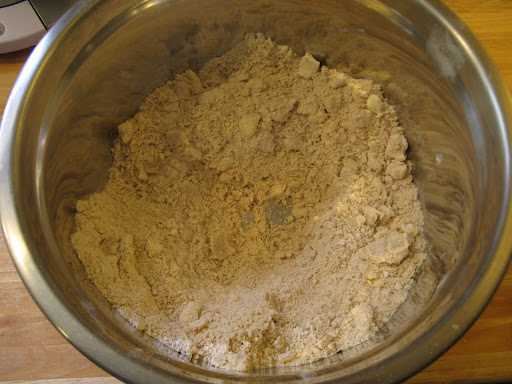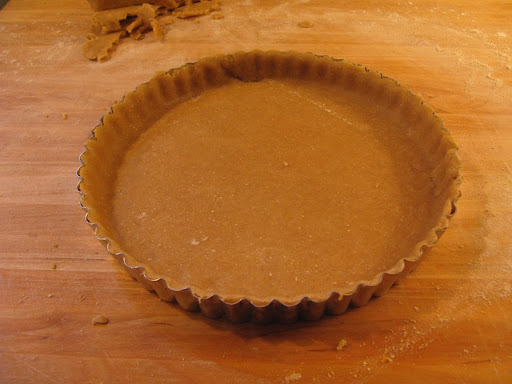Wow, it's almost been two months. I hope you haven't been holding your breath.
It is September 4th, and next week I start International Cuisine; the last class (three weeks long) before the six weeks of Restaurant Practical. If you're in the Portland area, I recommend you come by the school restaurant, because I will either be cooking or serving.
But right now, I'm practicing my desserts for my final practical test for the school (which is in the first week of the Restaurant Practical).
So here's a tart I made.

When it comes to baking, I have learned that a scale is the most important thing. Measuring flour cannot be done perfectly without it. Flour can clump together, so you could essentially fit a lot more into a cup, but the scale will not lie to you. Also, with baking, having the perfect amount of some of these ingredients is essential. These recipes aren't thrown together, they have been perfected over centuries, so please get a scale.
So, the essential ingredients are pastry flour, sugar, chilled butter, salt, lemon zest, eggs, and a little water.

Here, I am going to make pâte brisée (translation: broken dough), which is a short dough, meaning it is high in shortening, or fat, or butter.
Sift the flour, sugar and salt together.


Now, take the butter (make sure it's cold), and break it up into small, pea-sized bits. Using a cheese grater helps a lot. My hands are quite warm, so if I broke it up with my fingers, it would melt, which I don't want to happen.

Add the cut butter to the flour, and mix with your fingertips, making sure to 'cut' the butter into the flour. This is basically making sure the butter is still in small, pea-sized bits, and not completely mixed with the dry ingredients.

It should look like oatmeal, and there should be no big (bigger than a peanut) butter bits.

Now, mix the eggs, water, vanilla and lemon zest.

Make a well in the center of the dry ingredients, and pour in the wet.

Mix lightly to make a soft dough. You don't need to completely mix it yet.

Lay out the dough on a lightly floured surface, and knead a few times until it's completely mixed and holds its shape well.

When it gets to the point that the ball feels greasy, stop, because that means you are melting the butter.

Now, wrap in plastic and put it in the refrigerator for at least a half hour.
... a half hour later ...

Lay your dough ball out on a floured surface. Let it sit for a few minutes to kind of warm up, so it's pliable, or mash it around in your hands for a few seconds.

Pound it out and roll it out.

Pâte brisée should be rolled out to about 1/8 inch thick.

If you're having a hard time picking up the dough without breaking it, roll it around the rolling pin, and lay it on top of the tart pan.

Don't stretch the dough, because it will shrink when you bake it. Lightly press the dough into the corners, and push it down over the edge of the pan to cut off the extra.

Now, line it with a layer of cookie crumbs to absorb the liquid that will come out of the fruit.

Here i've got some really nice peaches and apricots from the Portland Farmer's Market, which are delicious and in perfect season right now.

Slice the peaches and apricots around the pit to de-pit them.

Slice them up!

Lay the slices in the tart shell as decoratively as you can. The peaches here are the focus here, so it's ok if it looks a little 'rustic'.

I put a few layers down, sprinkled some sugar over the top, put another layer in, and sprinkled some more sugar on top.


At this point, the tart makes itself.
Put it in the oven at 350 for 45 minutes. The fruit should get very tender and the dough should brown slightly.

While it's baking, you can make the apricot glaze that goes on top, to make it more appealing and shiny.
You can use whole apricots, but i just bought some apricot preserves and melted them in a pan with some water.

Bring it up to a boil, and when everything dissolves . . .


Strain it.

And it's baked!

Just brush the apricot glaze on top.
